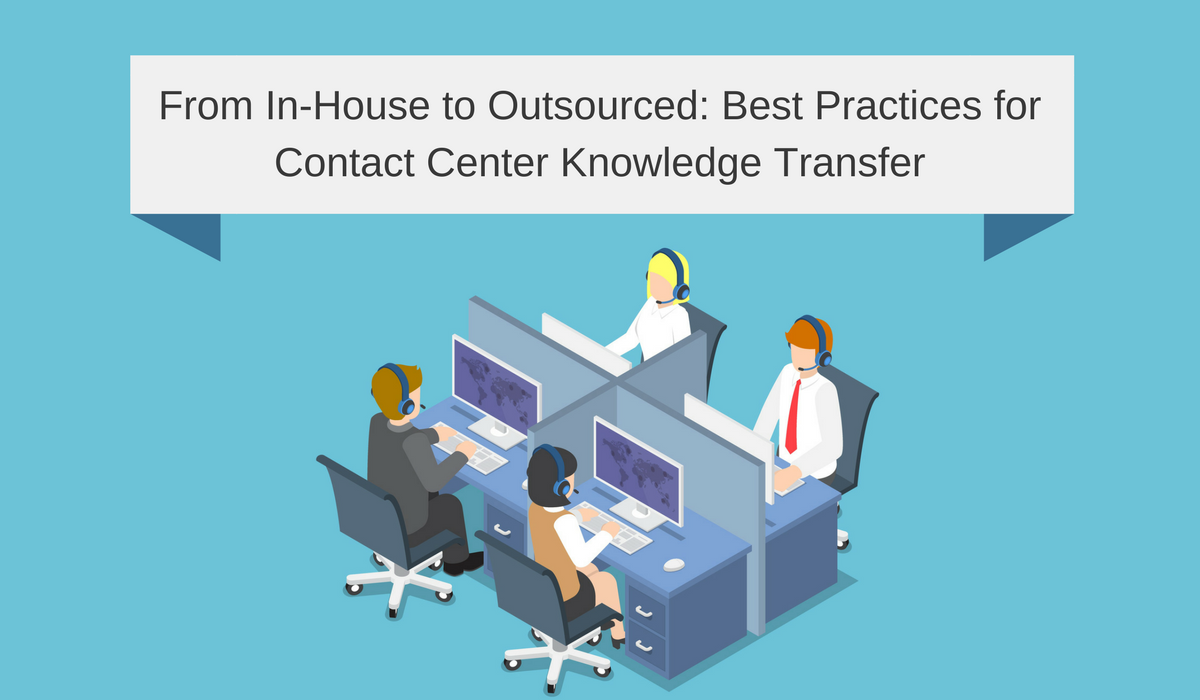From In-House to Outsourced: Best Practices for Contact Center Knowledge Transfer

In procuring an outsourced contact center partner, you’ve gone through the RFP process, you’ve made the site visit, you’ve narrowed down your decision, and, finally, you’ve signed the contract to make your choice official. The job of procurement might be done, but everything else is just getting started. Unless you want to throw your outsourcer in at the deep end (hint: really bad idea), then you need to turn your attention to agent training and contact center knowledge transfer.
Click here to get your copy of What Your Outsourcer Should Tell You About Training Contact Center Agents: A Client’s Guide.
Communicate Your Vision
Your company and its brand are unique. It can be intimidating to hand over customer care to a third-party when deciding to outsource, but you can turn that around by making sure your outsourced partner assimilates to your brand. You have a vision for the work you do, and now is the time to share it. Help new agents understand the mission and goals of their work, including both big picture goals and daily performance indicators, to ensure it will reflect in their performance. From the crafting of your RFP to the Statement of Work you develop with your new partner, your brand, your culture, your company’s voice, values, and vision must be clearly communicated.
Define Your Processes
Sometimes we don’t know what we don’t know – and it is possible that gaps will only be discovered when something goes wrong. You can mitigate against this risk. When protocols are too loosely defined, knowledge transfer can easily get lost in translation, leaving agents confused and faced with a wide array of possible customer service outcomes. In rapid growth scenarios or first time outsourcing scenarios, it pays to ensure that you prioritize the development of current, accurate work instructions. Step-by-step procedures and clearly defined rules are valuable assets in establishing a successful contact center. This is especially true when processes are changed or added at any point in the project; keep your agents in the loop and be sure to keep all lines of communication wide open.
Pay Attention to Your Team’s Inherent Knowledge
Teams share information. People teach each other the best, shortest, most effective ways to do things. Processes change on the fly and people get up to speed in whatever way they can. This is how inherent knowledge becomes part of your program. And this team knowledge is often undocumented. The transfer often happens peer-to-peer and eventually “everybody just knows.” This may include nuances in certain processes, especially in uncommon call scenarios or perhaps shifts in priorities when calls hit peak volume. This can also happen when there are frequent policy changes that affect customer service. You’re going to need a robust documentation process and change management protocol to move this inherent knowledge from one team to another – whether you are outsourcing for the first time or moving your program to a new strategic partner. You must be diligent is assessing and identifying these information gaps in order to strengthen the process of contact center knowledge transfer.
Get Involved in the Training Process
The best possible thing you can do to ensure successful knowledge transfer in your contact center is to get a subject matter expert from your company on-site at your outsourced partner to deliver hands-on training – at least in the burn-in phase of a new program. Although the best contact centers will have highly skilled training programs and trainers, mentoring “from the horse’s mouth” will be especially valuable. Additionally, depending on the product or service your company offers, allow agents to get hands-on product experience. This will help them better understand and empathize with customers who call with questions and frustrations. For example, when working with a major automotive client, each year when new models were introduced our client would bring cars on site and our agents would have a chance to get in the cars and explore the vehicles and new features.
Continually Monitor Progress
Your relationship with your contact center partner should be founded on, and grounded in, a strong governance model. Out of the gate, from the award of contract, you also need a robust implementation plan that will help both of you successfully transition your program and identify any areas where knowledge transfer may have been unsuccessful. These are the two most important components to set yourself up for long-term success in the new strategic partnership – good governance and a successful transition. Your program should continually evolve – and how you manage knowledge transfer between your team and your partner’s team will be an important piece of that evolution.
Knowledge Transfer in the Contact Center
Training customer service agents is an art and science, and contact center knowledge transfer is the link that holds it all together. Strong documentation, hands-on training, clearly defined processes, and communication are all part of a successful training program to ensure a smooth transfer from in-house to outsourced contact center.
Looking for more insight on agent training? Grab your copy of What Your Outsourcer Should Tell You About Training Contact Center Agents: A Client’s Guide today!
Related Articles:
Can You Train Contact Center Agents in Empathy?
Weighing the Pros and Cons of Cross-Trained Contact Center Agents
Three Secrets to Implementing an Outsourced Customer Service Program



